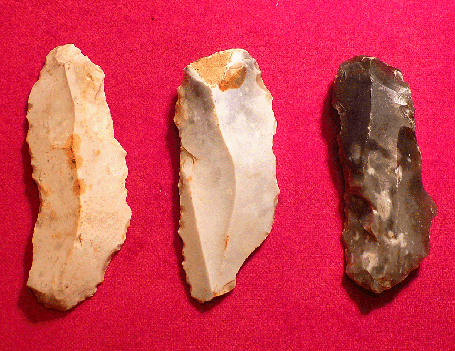How to identify flint tools
Identifying flint tools and weapons is more of an art than a science and experience is ultimately the best guide. However, there is a list of important indications of human manufacture and the more of them you can find in a flint, the more probable it is that you have found a stone age tool.
To understand the significance of much of the following list of criteria, you need to appreciate first how flint tools are made (click here).
Uniform patination
If the flint is uniformly patinated over all its facets (or all the facets on one side) then it is possible it could be of human make. If different facets have different degrees of patination, this is an indication they were not made at the same time, so the flint is unlikely to be an artefact. (See discussion on patination below for further details of this complex subject).
Retouching
Re-touching of one or more edges is a sure sign of human manufacture. Unfortunately it can sometimes be confused with edge damage that has been caused by knocking against the plough or other stones in the field (one reason why uniform patination is important). Edge damage tends to be random and discontinuous, while retouching is usually continuous and even overlapping.
Known design type
Stone age toolmakers were occasionally opportunist in adapting a flint that was unusual in shape. In the main, though, they stuck to established design patterns such as the side scraper or end scraper and hence these are the types most commonly found. If a flint conforms closely to a well-known design, that is a useful positive indication.
A note on patination
Flint is a surprisingly complex material and much about its formation and the way it weathers is still subject for debate. It used to be believed that the patina on a flint takes thousands of years to form and hence is a sure sign of great age. However, anyone who has collecting experience knows that you can find tools of the same type only inches from each other in the same field and one will be patinated all over while the other isn’t patinated at all! This suggests that patination may be the result of recent exposure rather than thousands of years of weathering – something that can vary from flint to flint and happen relatively quickly in some cases. The pictures below show patinated and unpatinated examples of tools of the same type from the same field.
 |
Three similar Mesolithic blades from the same field site all probably of the same age but in different stages of patination. Left: completely patinated with characteristic iron staining on the ridges between facets; Middle: partly patinated a milky blue; Right a glossy black patina (the grey patches are inclusions in the flint rather than superficial).